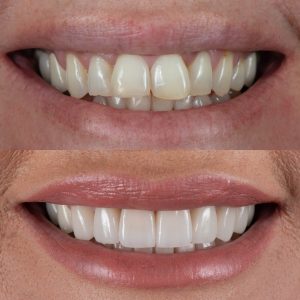Porcelain Veneers
Porcelain Veneers or Emax veneers or similar names essentially denote the same process. However, the most accurate explanation of this process is lamina porcelain veneer.
Contents
TogglePorcelain veneers provide an effective solution to problems such as fractures or deformations on tooth surfaces. Porcelains, which offer a similar texture and color with natural teeth, are integrated into the front surfaces of the teeth. These porcelains, which are in perfect harmony with other teeth, also carry the sensitivity to ideal levels. Although it exhibits a semi-permeable and thin appearance, the leaf teeth are as durable as possible.
Laminated porcelain, which minimizes the loss of healthy tooth tissue in different applications, is also in a unique position in this regard. During the application, minor abrasions ranging from 0.3 millimeters to 0.5 millimeters are made on the tooth surfaces. This ensures that healthy tooth tissue is not lost.
Conditions such as fracture or deformation due to trauma affect dental health negatively. In addition, decays may occur if care is not ignored. Developed to prevent negative situations on the tooth such as breakage or deformation and not to ignore aesthetic concerns while avoiding these, leaf tooth coating also gives perfect results in terms of harmony and sensitivity.
Among the most successful applications in the aesthetic framework among dental treatments, leaf tooth veneer is considered as important as health as well as appearance. After the treatment, the closest tissue to the natural tooth is obtained, and all patients who prefer leaf porcelain have healthy, white smiles. Dental Clinic Turkey is an address that has proven its success in aesthetic dental applications.
How Is Porcelain Veneer Made?

The appearance of the tooth models to be created is determined by the joint decision of the patient and the dentist. In this determination process, the morphological features of the facial features can also be taken into account. In addition to the facial features of the patient, the lips can also be decisive in the selection. Specific criteria such as the structure of the lips and their thickness should also be evaluated.
Finally, the structure of the upper posterior incisors should not be ignored while modeling the leaf tooth. If an ideal smile design is mentioned, all these factors are expected to be in harmony with each other.
A temporary coating is first applied to the model that has been decided. Options such as ceramic and zirconium are offered for veneers. These veneers are adhered to the problematic teeth and factors such as compatibility with other teeth and reaction to chewing movements are evaluated. If a positive opinion is given as a result of the observations made, a final correction is carried out. After the final fixes, it’s time for the actual skins.
The veneers, which are adhered to the tooth surface with special techniques, display a ready-to-use appearance from that moment on without any problems. Depending on the number and structure of the teeth to be coated, leaf veneer can be completely completed in two or three sessions.
What are the Advantages of Porcelain Veneers?
Aesthetic concerns are also determinative on the procedures performed by dentists. Increasingly, in recent years, aesthetic dental applications seem to be more successful with the development of technology and techniques. One of the most preferred applications in the context of aesthetics is leaf tooth porcelain veneer. The advantages of leaf teeth can be summarized as follows:
Lamina porcelains are very close to natural teeth in appearance. Leaf teeth, which are as durable as possible despite their thin structure, can be used comfortably for a long time.
Regardless of the number of teeth you have problems with, you can choose leaf teeth. Leaf teeth, which can be applied to a single tooth or to more than one tooth, also offer advantages in this regard.
The color of lamina porcelain does not change over time. It does not cause problems such as discoloration depending on time.
The texture of these veneers, which have a smooth structure, is like a natural tooth. It is unlikely that you will feel any difference while chewing.
Leaf coatings, which are also very strong in terms of resistance, show a high resistance to breaking, stretching and tensile forces.
